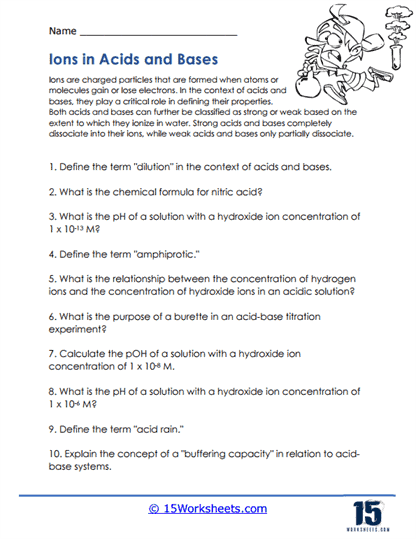Ions in Acids and Bases

Worksheet Description
The worksheet titled “Ions in Acids and Bases” delves into the fundamental principles surrounding the behavior of ions in acidic and basic solutions. It focuses on understanding how these ions play a crucial role in defining the properties of acids and bases. Topics range from the basic definitions and concepts of acid-base chemistry to practical aspects, such as titration.
This worksheet aims to:
Understand the nature and role of ions in acid-base systems.
Grasp concepts like dilution, amphiprotic behavior, and buffering capacity.
Recognize practical aspects like the role of a burette in titration.
Concept Explanation
Ions – Charged particles formed when atoms or molecules gain or lose electrons. In the context of acids and bases, their concentration and behavior determine the acidic or basic nature of solutions.
Dilution – The process of reducing the concentration of a solute in a solution, typically by adding more solvent.
Amphiprotic or Amphipathic – A substance that can both accept and donate a proton, behaving either as an acid or a base depending on the situation.
Relationship between Hydrogen and Hydroxide Ions – In any aqueous solution, the product of the concentration of hydrogen ions and hydroxide ions is a constant.
Burette in Titration – A piece of lab equipment used to deliver controlled and measurable quantities of a solution to another solution.
Acid Rain – Precipitation that has become acidic due to the presence of sulfuric and nitric acids from industrial emissions.
Buffering Capacity – The ability of a buffer solution to resist changes in pH when an acid or base is added.
